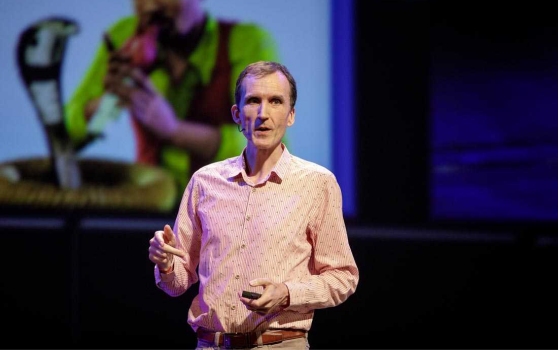“We need to use less” - chatting with Camp Digital speaker Gerry McGovern
2 minute read
Ahead of his Camp Digital talk on 23rd June, author of World Wide Waste Gerry McGovern discusses the environmental impact of digital and how designers and consumers can work to reduce this.
How do digital products impact the environment?
“There are two key ways in which digital is contributing to the destruction of the planet: one is the energy required to power devices and the other is the physical devices themselves and how we currently manufacture, use and dispose of these. Both are damaging the planet, but there are ways of mitigating the impacts.”
Let’s start by talking about e-waste. What are the current issues around our digital devices?
“When you buy a laptop, it has already generated 300kg of carbon dioxide emissions in the manufacturing process, and a smartphone has generated around 60kg. To put this into perspective, running a smartphone for a year will lead to 5kg of carbon emissions, so the manufacturing process really is the most energy-intensive part and minimising this needs to be the priority.
“We extract 100 billion tonnes of materials from the earth each year and this is growing exponentially. In 1970, the figure stood at 29 billion tonnes and by 2050 it is expected to be 170 billion tonnes. This is an enormous quantity to be extracted each year – consider that the entire mass of Mount Everest is only 150 billion tonnes. This needs to be cut down, and the only way to achieve this in digital is to manufacture fewer devices, which means using current ones to their full potential, taking care of them for as long as possible and reusing the materials they are made from once they have reached the end of their working life.
“There is a growing trend of refurbishment and recycling within tech and digital. Companies such as Apple, Samsung and Amazon offer refurbished products, but consumers still largely want new, and this is a habit that needs to be curbed. Digital is an amazing asset in life, but society needs to stop craving cool and new and understand how consumption is killing the planet. Be careful with your devices, try and get another year of life out of your phone or laptop, you don’t have to upgrade every time a new iPhone is released.
“Running in parallel with this is recycling devices. How many of us have an old, unused phone or laptop sitting in a drawer at home gathering dust? This applies to consumers and businesses alike. Currently, only 20% of computers are recycled, meaning that more and more materials are being mined rather than extracted from old devices and reused. A smartphone can have up to 1,000 different materials and these will include rare earth materials, so we need an enhanced focus on recycling, or urban mining, as there will soon be as many rare earth materials in e-waste as there are in the ground. As soon as you are finished using a device, donate it or sell it to be reused or recycled before its value depreciates, which it will do if you wait before doing something constructive with it.”
What about the intangible elements of digital? What impact are they having on the environment?
“The internet is the biggest machine ever made, and as all machines do, it uses large quantities of energy. We talk about “the cloud”, which is deceiving because it’s not a cloud, it is 7.2 million energy-hungry data centres where hundreds of servers require round the clock powering and cooling. Data emits carbon, but 90% of data is rubbish that isn’t used three months after it is created. The internet is a vast wasteland that is using energy to achieve not a lot.
“In 2010, there were about two zettabytes of data in the world and by 2035, it is estimated that there will be over 2,000. A zettabyte isn’t something we can see to know how big it is, so for comparison to print a single zettabyte of data on A4 paper, you would need to cut down nearly six times more trees than there are on the entire planet. Tackling the issue is something that the tech industry and consumers need to do together.”
What does the tech industry need to do to solve the data issue?
“Just as with devices, there needs to be a greater emphasis on reusing digital design. Design systems are supporting this already. Rather than building new web elements, designers can access and use pre-existing ones to avoid creating more data. Every design decision should be led by questioning whether new data needs to be created, or if it can be repurposed from something that already exists.
“Another element to keep in mind is the energy intensiveness of new products. For example, could an app be less draining on a phone’s battery? Could colours, images or functions be limited to reduce the amount of power needed? The most recent Windows 11 update uses devices’ time zones to calculate when electricity is the cheapest and will update during those times to limit demand on the grid, so recognition of this is making its way into the mainstream and its brilliant to see this conscientious approach from some major tech players.”
And what can consumers do?
“For consumers of digital products, the best advice is to make good habits. If you have data that you no longer need stored on your phone or laptop, get rid of it. Almost everyone is guilty of being a digital hoarder, but chances are you don’t need the tens of thousands of photos you have on your phone or loads of apps that are updating and downloading and refreshing in the background.
“The more locally data is stored the better – a hard drive is 3,000 times less polluting than the cloud. So, take your photos off your phone and off the cloud and put them on a hard drive. If you haven’t revisited any of those photos in a year or two, delete them and put the ones you have accumulated in that time on the hard drive. Also in that time, try and be more mindful of what you are taking photos of and delete blurry or unneeded images straight away. We took 1.4 trillion photos last year, which is more photos that were taken in the entire 20th Century. It is just not necessary.
“Unneeded data should be deleted. I keep two years of emails saved and am in the habit of deleting a year’s worth of emails every January. I run a business, and I have not once ever been negatively affected by deleting emails older than two years. Little and often is the best approach – if you’re accessing a document in a folder, have a quick look over the folder and see if there is anything that can be deleted. Do you really need four versions of the same presentation in varying levels of completion? Because of the way data is consumed currently, cutting it down may feel overwhelming, but it doesn’t need to happen overnight – small, regular changes will still lower your digital carbon footprint.”

“For consumers of digital products, the best advice is to make good habits. If you have data that you no longer need stored on your phone or laptop, get rid of it. Almost everyone is guilty of being a digital hoarder, but chances are you don’t need the tens of thousands of photos you have on your phone or loads of apps that are updating and downloading and refreshing in the background."
What is the main takeaway about digital and the environment?
“We need to use less. Fewer new devices with virgin materials and less new data. It is no secret that humans are destroying the earth, and yes there may be more significant drivers of global warming, but every designer, person and business has the potential to fight climate change through more mindful and considered use of digital. Many won’t realise that digital is impacting the environment, so we need to get the word out and get everyone into better and more sustainable digital habits.”
Hear Gerry's talk "Earth Experience Design" at Camp Digital on 23rd June.
Tickets for both the conference in Manchester and the main stage live stream are available for purchase right here.

